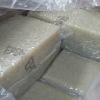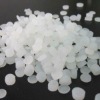- HIPS[1]
- PP[1]
- LDPE[1]
- PVC[1]
- PA[3]
- TPE[7]
- Paraffin[7]
- Other Rubber Products[4]
- Styrene Butadiene Rubber[3]
- Organic Acid[4]
- Phosphate[3]
- Blended Yarn[2]
- 100% Cotton Yarn[5]
- Ceiling Tiles[7]
- Other Plant & Animal Oil[6]
- ABS[1]
- Contact Person : Ms. Zhang Amanda
- Company Name : Wuhan Hangyu International Import And Export Co., Ltd.
- Tel : 0086-27-82962170
- Fax : 0086-27-82962171
- Address : Hubei,Wuhan,Room 301, Unit 2, Building 6, Xiangli Tingyuan, Shiji Yuan, No. 28, Jinqiao Road, Jiang'an District
- Country/Region : China
High quality EPDM rubber
EPDM rubber (ethylene propylene diene monomer (M-class) rubber), a type of synthetic rubber, is an elastomer which is characterized by a wide range of applications. The E refers to ethylene, Pto propylene, D to diene and M refers to its classification in ASTM standard D-1418. The M class includes rubbers having a saturated chain of the polymethylene type. Dienes currently used in the manufacture of EPDM rubbers are dicyclopentadiene (DCPD), ethylidene norbornene (ENB), and vinyl norbornene (VNB). EPDM rubber is closely related to ethylene propylene rubber (ethylene propylene rubber is a copolymer of ethylene and propylene whereas EPDM rubber is a terpolymer of ethylene, propylene and a diene-component).
The ethylene content is around 45% to 75%. The higher the ethylene content the higher the loading possibilities of the polymer, better mixing and extrusion. Peroxide curing these polymers give a higher crosslink density compared with their amorphous counterpart. The amorphous polymer are also excellent in processing. This is very much influenced by their molecular structure. The dienes, typically comprising from 2.5% up to 12% by weight of the composition, serve as crosslinks when curing with sulphur and resin, with peroxide cures the diene (or third monomer) functions as a coagent, which provide resistance to unwanted tackiness, creep or flow during end use.
PropertiesEPDM exhibits satisfactory compatibility with fireproof hydraulic fluids, ketones, hot and cold water, and alkalis, and unsatisfactory compatibility with most oils, gasoline, kerosene, aromatic and aliphatic hydrocarbons, halogenated solvents and concentrated acids.
The main properties of EPDM are its outstanding heat, ozone and weather resistance. The resistance to polar substances and steam are also good. It has excellent electrical insulating properties.
Typical properties of EPDM vulcanizates are given below. EPDM can be compounded to meet specific properties to a limit depending first on the EPDM polymers available, then the processing and curing method(s) employed. EPDMs are available in a range of molecular weights (indicated in terms of Mooney viscosity ML(1+4) at 125 °C), varying levels of ethylene, third monomer and oil content.
Mechanical properties of EPDM | |
Property | Value |
Hardness, Shore A | 40–90 |
Tensile failure stress, ultimate | 25 MPa |
Density | Can be compounded from 0.90 to >2.00 g/cm3 |
Thermal properties of EPDM | |
Property | Value |
Coefficient of thermal expansion, linear[3] | 160 µm/m·K |
Maximum service temperature[4] | 150 °C |
Minimum service temperature[4] | −50 °C |
Glass temperature | −54 °C |
EPDM rubber is used in seals (for example it is used in cold-room doors since it's an insulator as well as in the face seals of industrial respirators in automotive paint spray environments, where silicon must be avoided). EPDM is also used in glass-run channels, radiators, garden and appliance hose, tubing, pond liners, washers, belts, electrical insulation, vibrators, O-rings, solar panel heat collectors, UV protection (for tubular motors in shutters) and speaker cone surrounds. It is also used as a medium for water resistance in electrical cable-jointing, roofing membranes (since it does not pollute the run-off rainwater, which is of vital importance for rainwater harvesting), geomembranes, rubber mechanical goods, plastic impact modification, thermoplastic, vulcanizates, and many other applications.[5][6]Granulated, colored EPDM granules are mixed with polyurethane binders and trowled or sprayed onto concrete, asphalt, screenings, interlocking brick, wood etc. to create a non-slip, soft, porous safety surface for wet-deck areas such as pool decks or playgrounds.
The most common use however is probably in vehicles. It is used in door seals, window seals, trunk seals, and sometimes hood seals, frequently these seals are the source of noise due to movement of the door versus the car body due to friction between the EPDM rubber and the mating surface (car painted sheet metal or glass). This can be alleviated using specialty coatings that are applied at the time of manufacture of the weather seal, such coatings can also greatly increase the chemical resistance of EPDM rubber. Some vehicle manufacturers also recommend a light application of silicone dielectric grease to weatherstripping to reduce noise. Other uses in vehicles include cooling system circuit hoses where water pumps, thermostats, EGR valves, EGR coolers, heaters, oil coolers, radiators and degas bottles are connected with EPDM hoses; as well as charge air tubing on turbo charged engines to connect the cold side of the charge air cooler (intercooler) to the intake manifold.
Product picsHigh quality EPDM rubber




